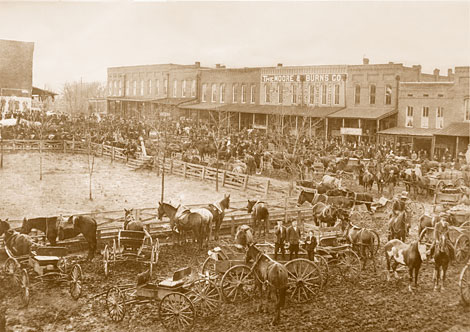History
 Originally inhabited by the Chickasaw Indian Tribe, the first settlers started moving into this area during the early 1800s.
Originally inhabited by the Chickasaw Indian Tribe, the first settlers started moving into this area during the early 1800s.
In the original settling of what is now McKenzie, there were two families here that were "rivals". Each named the part of this towns area that they lived in a different name. One part of McKenzie was named Marrieta and the other part Dundas. It was still like this during the Civil War even though the community had much more to worry about at that time than the "rivalry' between the Sneads and the Gilberts. At that time there was a rather big family of McKenzie's that lived here. (From Joe Stout’s notes on “War Leaflets”, a delightful and emotional chronicle by Annie Cole Hawkins. In it you can read about many more geographical and societal norms of the region).
The city of McKenzie was organized in 1867 when the Nashville and Northwestern Railroad completed its track and intersected with the Memphis and Ohio Railroad. Its name was derived from the family that previously owned the land where the railroads crossed. James Monroe McKenzie gave the property to the railroad company with the stipulation that his son George McKenzie be given the position of station agent for the Nashville, Chattanooga and St. Louis Railroad. First known as McKenzie Station, it was soon shortened to McKenzie. The town began to develop rapidly after the tracks were completed and was officially incorporated by the state of Tennessee on January 22, 1869.
The railroad drew many residents from the neighboring communities, among them Caladonia and McLemoresville. By 1870, the population of McKenzie had grown to over 500 residents. In the 1880's the size of the town doubled and business thrived. On October 15, 1887, the President of the United States, Grover Cleveland, visited the bustling town and stayed overnight at the McKenzie Hotel. By the turn of the century, a city park was created, public schools were built and roads paved with gravel. The town continued to expand at a steady rate until the Great Depression struck in October of 1929. Banks and businesses closed their doors and the community's labor base evaporated overnight. It would be not until 1936 that conditions began to show economic growth and improvement.
Just prior to the World War 2, the federal government began construction on a munitions plant and arsenal east of Milan. During the war, the plant would hire thousands of laborers and increase the population of McKenzie more than any time in its history. Between 1940 and 1950, the population of the city increased by over 1,300 people and was second to only Oak Ridge in population growth statewide. Following the war the city has kept a steady rate of growth and continues to be a productive and prosperous community (Adapted from RootsWeb.com).